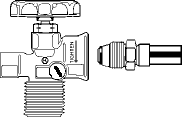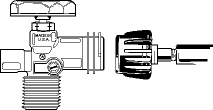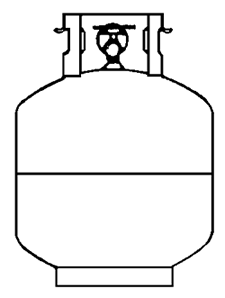Acme or POL valve required for RV propane cylinders & cylinder re-certification
The Federal government prohibited the sale and use of POL valves found on older DoT type propane cylinders. (POL is an abbreviation for Prest-O-Lite, for the company that first produced the valve). These valves have the familiar female left-hand-thread in the valve and are the type most of us currently have. Cylinders with this type valve were discontinued beginning in the year 2000, and may may no longer be refilled.
The old POL valves were replaced by a new Acme type which uses a QCC (Quick Closing Coupling) connector. This connector has an external (male) right-hand thread on the valve. A pigtail hose can be connected and disconnected by hand... no wrench required. These valves also have the old-style POL internal left-hand thread, so they can be used directly in place of the old valves without modifying your RV. If you like the no-tools convenience of new style connector you may want to replace your pigtail hoses with new ones having the QCC connectors.
The new ACME or QCC valve also contains an OPD (Overfill Protection Device). So you may find them called ACME valves, OPD valves or QCC valves, depending on the supplier. The OPD feature prevents accidental overfill of the cylinder. An internal float mechanism shuts off the valve when the propane tank is 80% filled. The 20% empty space is necessary to prevent the cylinder from venting large amounts of propane when the temperature rises. (ASME type cylinders in most motorhomes have had this OPD feature for many years). The new OPD valve also contains another safety feature - it will not release gas unless the pigtail hose is properly connected, even with the valve open.
POL Valves
 The old-style cylinder valve is known as a POL valve, named for the manufacturer that devised it. You tighten the connector of the regulator pigtail by turning the fitting counter-clockwise, and you usually need to use a wrench to make the connection tight enough to prevent leaks. With a POL valve, if you open it with no fitting attached, propane is freely released. That's why a plug is required to be screwed into the valve during transport of the cylinder and when it is stored or not connected to your RV. The plug is an attempt to prevent an accidental opening of the valve from creating a dangerous situation.
The old-style cylinder valve is known as a POL valve, named for the manufacturer that devised it. You tighten the connector of the regulator pigtail by turning the fitting counter-clockwise, and you usually need to use a wrench to make the connection tight enough to prevent leaks. With a POL valve, if you open it with no fitting attached, propane is freely released. That's why a plug is required to be screwed into the valve during transport of the cylinder and when it is stored or not connected to your RV. The plug is an attempt to prevent an accidental opening of the valve from creating a dangerous situation.
This valve also has a built-in bleeder valve the service technician uses to check for proper filling and a pressure relief device to prevent over pressurization of the cylinder.
ACME Valves
 This valve is also known as QCC (Quick Closing Coupling) or OPD (Overfill Protection Device) The New ACME valve looks bulkier because there are external threads visible. The external threads don't necessarily require a change to the connector on the end of the regulator pigtail hose. They are compatible, as the left-hand-thread fitting on your RV regulator will screw into the internal POL threads of the new ACME valve.
This valve is also known as QCC (Quick Closing Coupling) or OPD (Overfill Protection Device) The New ACME valve looks bulkier because there are external threads visible. The external threads don't necessarily require a change to the connector on the end of the regulator pigtail hose. They are compatible, as the left-hand-thread fitting on your RV regulator will screw into the internal POL threads of the new ACME valve.
However, one of the benefits of the new connector is that it is designed to be attached to the cylinder without tools. You only have to hand-tighten the connector. And, you tighten as you would normally tighten a threaded fitting, by turning it to the right (clock-wise). So at the cost of a few dollars it may be good to replace the pigtail hoses.
Propane Cylinder Re-certification
 If you have an older RV��you should know that according to Federal law, DoT cylinders may only be used for 12 years after their manufacture date. After that, the cylinders must be "re-certified" which provides another five years of use. The cylinders can be re-certified every five years thereafter.
If you have an older RV��you should know that according to Federal law, DoT cylinders may only be used for 12 years after their manufacture date. After that, the cylinders must be "re-certified" which provides another five years of use. The cylinders can be re-certified every five years thereafter.
Propane dispensers are legally required to look at the date stamped on the cylinder before filling it. Some dealers actually do look. We've been reminded a few times that our cylinders were about to expire. Check the date stamped on your cylinders... don't rely on your rig's model year even if the cylinders are original. It's quite possible they are a year or more older than your rig. Ours were.
Re-certification is usually done by the large bulk propane suppliers but we found one of our local RV repair shops was certified to do the job and they do it for free! Call around to see who may do it in your area.
A safety note for you: Propane cylinders of the DoT design must be transported and stored in an upright position so the pressure relief device will function properly. Laying the cylinder on its side in the trunk of your car is a potentially very dangerous situation.
You may also want to read: Propane Safety Tips for RVers


